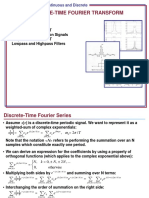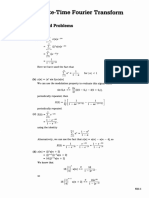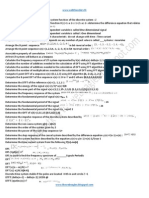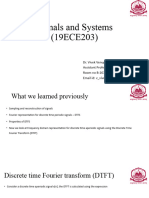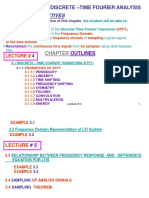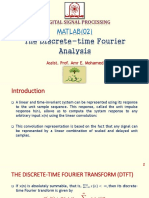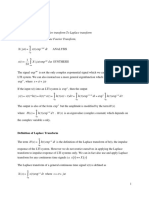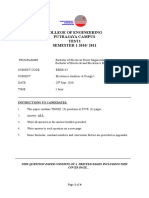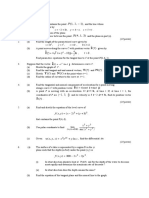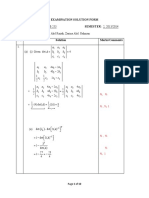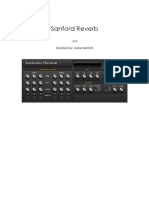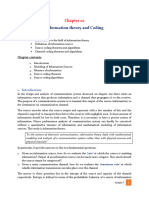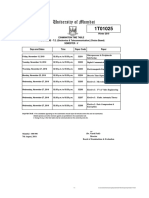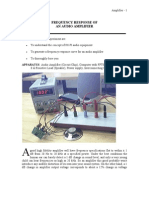Week 11 Lecture
The Discrete Time Fourier Transform (DTFT)
Representation of Aperiodic Discrete Time Signals Using The Discrete Time Fourier
Transform
The Discrete Time Fourier Transform of an aperiodic discrete time signal is an extension
of the Fourier Series of the discrete time periodic signal. The Discrete Time Fourier
Transform (DTFT) transforms a an aperiodic discrete signal x(n) in the time domain and
creates X e j in the discrete FREQUENCY domain. In the discrete frequency domain
X e j is a CONTINUOUS function of the discrete frequency
Consider an arbitrary aperiodic discrete time signal x[n] which is of finite duration as
shown. Now let’s have a discrete time periodic signal x[n] of which over one period N,
x[n] x[n] If we now choose a larger period, N, x[n] x[n] over this larger period also.
However, the Fourier Series coefficients of x[n] now gets closer with the increased
period N.
Now if we let N of the periodic x[n] , x[n] x[n] for any finite value of n i.e the
periodic discrete time signal x[n] is identical to the aperiodic x[n] We will see that the
Fourier Series coefficients of x[n] becomes continuous as N . The Discrete Time
Fourier Transform X e j can be seen as a "continuous coefficient" of the Fourier Series
if we let the period of the discrete time periodic function goes to infinity.
Given an aperiodic discrete time signal x[n], the DTFT i.e the Discrete Time Fourier
Transform is defined as
X e j x[n]exp jn DTFT Discrete Time Fourier Transform
(Analysis Equation)
1
� X e exp
1
x[n] jw j n
d DTIFT (Discrete Time Inverse Fourier Transform)
2 2
(Synthesis Equation)
The discrete-time Fourier transform have the following characteristics which differ from
the continuous time Fourier Transform
1. The DTFT are periodic. X e j X e j ( 2 k )
2. The interval of integration of Inverse DTFT are finite i.e over 2
X e j exp jn d
1
2 2
x[n]
3. Note that x[n] is a function of the discrete time variable n while the Fourier
Transform X e j is a continuous function of the discrete frequency .
Recap
Recall that for the discrete time case, the complex exponential sequences which differ in
frequency by a multiple of 2 are identical..
Let a discrete time signal with an arbitrary frequency of k 0 i.e k [n] exp jk0n and
2
0 where N is the period of the signal.
N
Then at a ‘higher frequency’ of (k+N)ω0 .
2
j k 0n
j k N 0n 0
k N [n] exp exp
exp jk0n exp j 2 n exp jk0n since exp j 2 n 1
So k [n] k N [n] when the frequency k0 has increased to (k+N)ω0 .
Note that N is an integer chosen to represent the amount of increase in frequency. (Note
that the same N is also the length of the period at the frequency k0 ). Also for discrete
time, the highest frequency is . Since k [n] k N [n] , this means that a signal of
k0 frequency is identical to (k+N) 0 frequency.
2
�Example 1
n
1
Given a discrete time signal x[n] u n , calculate the discrete-time Fourier
3
transform.
There are 2 ways which you can use to find the DTFT i) by the analysis equation and ii)
by using the Fourier Transform table.
Method 1 By using the analysis equation,
n n n
1 1 1
X e j x[n]exp jn u[n]exp jn exp jn exp j
3 0 3 0 3
n
1
X e j exp j
1
0 3 1 exp j
1
3
Method 2 By using the Transform Table
n
1
x[n] u n
3
X e j
1
1
1 exp j
3
Note that the function X e j is a continuous function of the discrete frequency
Note that the reason for the periodicity of X e j can be easily seen in this expression
X e j
1
. As the discrete frequency increases, the term exp j can only
1
1 exp j
3
alternate between negative one and positive one. As increases to infinite, the function
X e j will therefore repeats in a periodic manner.
3
� 1
Fourier Transform of x[n] a u n a=
n
Example 2
Find the discrete-time Fourier Transform of the signal defined below:-
1 n N1
x[n]
0 n >N1 N1 2
x[n]
-2 0 2
X e j x[n]exp jn 1exp jn
2
2
Let 𝑚 = 𝑛 + 2
4
�. X e j 1exp jn 1exp j m2 exp jm exp j 2 exp j 2 exp jm
2 4 4 4
2 m0 m0 m0
1 exp j
5
X e exp exp
4
j j 2 j m j 2
exp
m0 1 exp j
j
5 5
j j
5
exp 2 exp 2 exp 2
1 exp j 5
X e j exp j 2 exp j 2
1 exp j j j
j
exp exp exp
2 2 2
j
5 5
j
5
5
2 j sin
j 5
j
exp exp exp
2 2 2 2
exp
2
X e j exp j 2 exp j 2
j
j j j
exp exp exp
2 2 2
2 j sin exp 2
2
j
5
5 5 5
sin 2 sin
2
exp sin
5
X e j exp
2 X e j 2
j
2
sin sin sin
2 2 2
𝑋(𝑒 𝑗𝜔 )
Note that X e is periodic with a period of 2
j
in frequency
5
�The Convolution Property
y[n] x[n]* h[n] , This implies Y e j X e j H [ e j
Example 3
n
1
Consider an LTI system with impulse response h[n] u n . Suppose the input to
2
1 𝑛
the system is,𝑥[𝑛] = (3) 𝑢(𝑛) find the output response y[n]
y[n] x[n]* h[n] or Y e j X e j H [ e j
From the Fourier Transform Pair Table
X e j H e j
1 1
1 1
1 exp j 1 exp j
3 2
Y e j X e j H [ e j = Y e j
1
1 j 1 j
1 3 exp 1 2 exp
Y e j
1 A B
1 j 1 j 1 j 1 j
1 3 exp 1 2 exp 1 3 exp 1 2 exp
For the discrete time case, when solving using the partial fraction, it is neater to deal with
𝑒 −𝑗𝜔
1
A can be obtained by using the cover up rule, and let 𝑒 −𝑗𝜔 = 3, 𝐴 = 3 = −2
1−
2
1
B can be obtained by using the cover up rule, and let 𝑒 −𝑗𝜔 = 2, B= 2 = 3
1−
3
−2 3
𝑌(𝑒 𝑗𝜔 ) = +
1 1
(1 − (3) 𝑒 −𝑗𝜔 ) 1 − (2) 𝑒 −𝑗𝜔
n n
1 1
Based on the Fourier Transform pair table, y[n] 2 u (n) 3 u (n)
3 2
6
�Example 4
1 𝑛
A discrete time LTI system with impulse response ℎ[𝑛] = (5) 𝑢[𝑛].
1 𝑛
Find the output response y[n] to the input signal 𝑥[𝑛] = [𝑛 + 1] (3) 𝑢[𝑛].
From the Fourier Transform Pair Table
1 1
𝐻(𝑒 𝑗𝜔 ) = 1 𝑋(𝑒 𝑗𝜔 ) = 1 2
1−( )𝑒 −𝑗𝜔 (1−( )𝑒 −𝑗𝜔 )
5 3
1 1
𝑌(𝑒 𝑗𝜔 ) = 𝑋(𝑒 𝑗𝜔 )𝐻(𝑒 𝑗𝜔 ) =
1 1 −𝑗𝜔
2
(1 − (3) 𝑒 −𝑗𝜔 ) 1 − (5) 𝑒
1 1
𝑌(𝑒 𝑗𝜔 ) =
1 2 1 −𝑗𝜔
(1 − (3) 𝑒 −𝑗𝜔 ) (1 − (5) 𝑒 )
𝐴 𝐵 𝐶
= + +
1 2 1 1
(1 − (3) 𝑒 −𝑗𝜔 ) (1 − (3) 𝑒 −𝑗𝜔 ) (1 − ( ) 𝑒 −𝑗𝜔 )
5
For the discrete time case, when solving using the partial fraction, it is neater to work
with 𝑒 −𝑗𝜔 .
1 5
A can be obtained by using the cover up rule, and let 𝑒 −𝑗𝜔 = 3, 𝐴 = 3 =
1− 2
5
1 9
C can be obtained by using the cover up rule, and let 𝑒 −𝑗𝜔 = 5, 𝐶 = 5 2
=
(1− ) 4
3
1 2 1
To obtain B, one need to multiply L.H.S and R.H.S by (1 − (3) 𝑒 −𝑗𝜔 ) (1 − (5) 𝑒 −𝑗𝜔 )
We obtain
1 1 1 1 2
1 = A(1 − (5) 𝑒 −𝑗𝜔 ) + 𝐵 (1 − (3) 𝑒 −𝑗𝜔 ) (1 − (5) 𝑒 −𝑗𝜔 ) + 𝐶 (1 − (3) 𝑒 −𝑗𝜔 )
By equating the constant only, we obtain
5 9 8−20−18
1 = 𝐴 + 𝐵 + 𝐶 𝑜𝑟 𝐵 = 1 − 𝐴 − 𝐶 = 1 − 2 − 4 = 8
7
� 15
𝐵=−
4
By substituting the values of A, B and C, we obtain
5 15 9
−
𝑌(𝑒 𝑗𝑤 ) = 2 + 4 + 4
1 −𝑗𝜔 2 (1 − (1) 𝑒 −𝑗𝜔 ) 1 −𝑗𝜔
(1 − ( ) 𝑒 )
(1 − (3) 𝑒 ) 3 5
5 1 𝑛 15 1 𝑛 9 1 𝑛
Thus 𝑦(𝑛) = 2 (𝑛 + 1) (3) 𝑢(𝑛) − (3) 𝑢(𝑛)+4 (5) 𝑢(𝑛)
4
Frequency Response of Discrete-Time LTI System
As in the continuous-time LTI, a discrete time LTI system only has a frequency response
if the system is stable.
An LTI system is stable if its impulse response is absolutely summable, i.e
n
h[n]
n
Systems Characterized by Linear Constant Coefficient Difference Equations
A causal LTI system is described by the difference equation
3 1
y[n] y[n 1] y[n 2] 2 x[n]
4 8
i) Find the frequency response H e j of an causal LTI system described by the
difference equation
n
1
ii) If a discrete time signal x[n] u[n] is input into the system, what is the
4
output y[n]
iii) Calculate the impulse response of the system.
8
�Solution
i) Note that a time-shift in the time domain of n0 has the effect of multiplying
the Fourier Transform by expn0 i.e y n n0 exp jn0 Y e j Taking the
Fourier Transform of each term, we obtain
Y e j exp j Y e j exp j 2 Y e j 2 X e j
3 1
4 8
Y e j
The frequency response H e X
j 2
e
j
3 j 1 j 2
1 e e
4 8
n
1
Since the input x[n] u[n] X e j
1
ii)
4 1
1 exp j
4
Y e j
2 1 2 1
3 1 j 2 1
1 1 exp j 1 1
1 4 exp 1 exp j 1 exp
j j j
1 exp exp 2
4 8 4 4
Y e j
2 1 2
1 j 1 j 1
1 1 exp j 1 1 exp j
2
1 exp 1 exp 1 4 exp
j
2 4 2
4
Solving using partial fraction
Y e j
2 A B C
1 j 1 j
2
1 j 1 j 1 j
2
1 exp 1 exp 1 exp 1 exp 1 exp
2 4 2 4 4
Solving for A,B, C , A = 8, B = -4, C = -2
4 2
Y e j
8
1 j 1 j 1 j
2
1 exp 1 exp 1 exp
2 4 4
9
�From the Fourier Transform pair table,
n n n
1 1 1
y[n] 8 u[n] 4 u[n] 2[n 1] u[n]
2 4 4
iii) The impulse response h[n] is simply the DTIFT of
H e j
2
3 j 1 j 2
1 e e
4 8
H e j
2 2
3 j 1 j 2 1 j 1 j
1 e e 1 exp 1 exp
4 8 2 4
Using partial fraction expansion
H e j
A B
1 j 1 j
1 exp 1 exp
2 4
Solving for A and B, A= 4 and B = - 2
H e j
A B 4 2
1 j 1 j 1 j 1 j
1 exp 1 exp 1 exp 1 exp
2 4 2 4
n n
1 1
From the Fourier Transform Pair table, h n 4 u[n] 2 u[n]
2 4
10
�Properties of DTFT
The properties of DTFT are very similar to those of the continuous time Fourier
Transform. See the Properties of The Fourier Transform table.
Fourier Transform Pairs
Time Domain Signal Fourier Transform
f (t )
f (t )exp jt dt
1
F j exp
jt
d F j
2
1
exp at u(t ) a>0
a j
1
expbt u(t ), b>0 a>0
b j
t 1
A t t0 A exp jt0
1
u (t )
j
1 2
exp j0t 2 0
K 2 K
cos 0t 0 0
A cos 0t
A exp j 0 A exp j 0
11
�
sin 0t 0 0
j
ak exp jk0t periodic function
k
2 a k
k
k 0
2
2
t nT
k
periodic impulse
T
T
k
k
sin c t rect
2
t T
rect T sin c
T 2
T
sin
1 1 2
ut T ut T
2 2
2
sin bt
u b u b
t
Table of Fourier Transform Properties
Property Name Time Domain: x(t) Frequency Domain: X j
Linearity ax1 (t ) bx2 (t ) aX1 ( j ) bX 2 ( j )
Conjugation x (t ) X ( j )
Time Reversal x t X ( j )
1
Scaling x at X j
a a
Delay x t td exp jd X j
Modulation x t exp j0t X j 0
12
� X j 0 X j 0
1 1
Modulation x t cos 0t
2 2
d k x(t )
j X j
k
Differentiation
dt k
Convolution x(t ) h(t ) X j H j
1
Multiplication x(t ) p(t ) X j P j
2
13




















